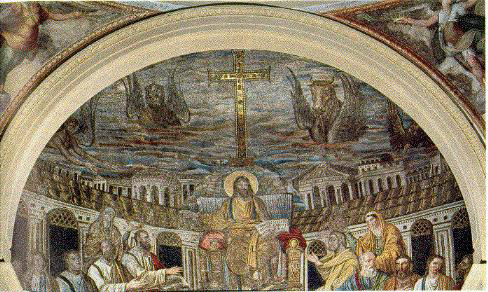Re: Re: reordering and destruction of irish cathedrals – St Colmans Cathedral, Cobh
Home › Forums › Ireland › reorganisation and destruction of irish catholic churches › Re: Re: reordering and destruction of irish cathedrals – St Colmans Cathedral, Cobh
Back to tympana and the decorative theme of Crist enthroned, surrounded by the tetramorphoi and the twelve Apostles. We have seen that the vesrion in the tympanum of the West Portal in Cobh (posting # ) is directly related to the tympanum of the Royal Portal at Chartres, which in turn, has its immediate iconographic prototypes in the Romanesque tympana, especially those associated with Burgundy and the Cluniac reform, depicting Christ enthroned, surrounded with the tetramorphoi, the Apostles and the Prophets. The earliest extant embyonic example is that of the West Portal of the Priory of St. Fortunat at Charlieu dating from about 1090. It depicts the enthroned Christ, in aureole supported by Angels. Although the type is associated wih Cluny and the investiture crisis, it too has a long art-typical history bringing us to Rome and the Basilica of Santa Pudenziana where we find the earliest extant example of Christ seated in glory, surrounded by the Apostles, the tetramorphoi, and surmounted by his victorious Cross. The mosaic dates from about 390 A.D..
A drawing of the mosaic reconstructing its original state.

The mosaic as preserved to-day.
“This mosaic is important for its iconography. It is the earliest surviving decorated Christian apse which takes us back to the period of classical revival in Rome. This mosaic was heavily restored during the Renaissance and the nineteenth c., but the Christ in the center is not changed, thus, in terms of style we have to look at Christ for analysis.
There is a high degree of classicism in the proportions, modeling, ease and movement, linearity has not yet quite taken hold. Thus we see a union of the old naturalism and the symbolism taking hold in the fifth century.
The subject is Christ teaching the apostles in front of heavenly Jerusalem.
The landscape behind him may be directly related to a reproduction of the Holy Sepulchre – Church built over Christ’s tomb in Jerusalem. The cross is symbolic of the true cross erected on Golgatha (hill on which Christ was crucified).
The four evangelists (gospel writers) are in their animal symbolic form. The iconography can be traced back to the Old Testament when Ezekial saw a vision in heaven of the four beasts spreading the word of the Gospel. It is also found in the book of Revelations. Matthew is the winged angel, Mark is the Lion, Luke is the Ox or bull, and John is the Eagle. Until the fourth c. the relationship between animal symbols and those whom they represented was not fixed.
Peter and Paul are being crowned by female figures who symbolize the church of the Jews behind Peter on the right, and the church of the Gentiles, behind Paul, originally there were 12 apostles, only ten can now be seen, due to restorations.
Again we see naturalism mixing with great symbolism of the Early Christian period. This naturalism will fade, the emphasis will become purely spiritual, other worldly, purposely making no or little reference to our natural world”.
